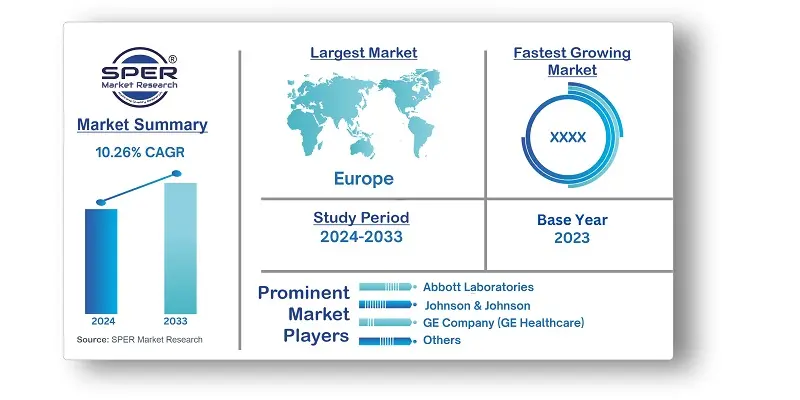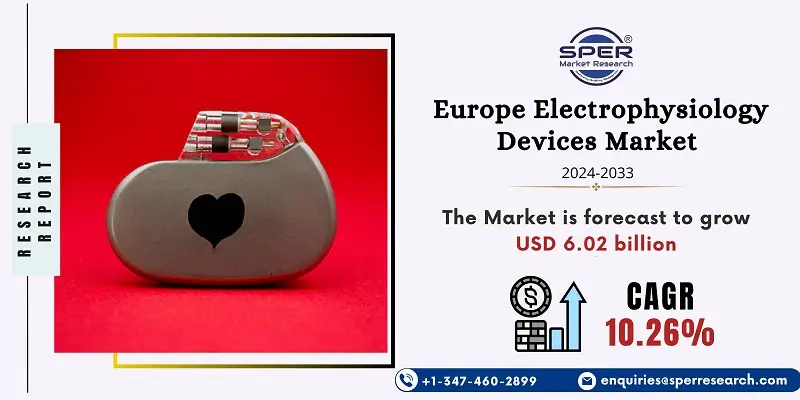
Europe Electrophysiology Devices Market Size, Growth, Trends, Revenue and Future Outlook
Europe Electrophysiology Devices Market Growth, Size, Trends Analysis- By Product, By Disease - Regional Outlook, Competitive Strategies and Segment Forecast to 2033
| Published: Nov-2024 | Report ID: MEDE2451 | Pages: 1 - 157 | Formats*: |
| Category : Medical Devices | |||
- Acutus Medical received CE Mark for its AcQBlate FORCE ablation catheter and the Qubic Force Sensing Module (Qubic Force), and in December 2020, the AcQBlate Force Sensing Ablation System was introduced in Europe.
- Farapulse's FARAPULSE Pulsed Field Ablation (PFA) technology, which treats paroxysmal atrial fibrillation (AF), was granted the CE Mark in January 2021.


| Report Metric | Details |
| Market size available for years | 2020-2033 |
| Base year considered | 2023 |
| Forecast period | 2024-2033 |
| Segments covered | By Product, By Disease |
| Regions covered | Eastern region, Western region, Southern region, Northern region. |
| Companies Covered | Abbott Laboratories, Biotronik SE & Co. KG, Boston Scientific Corporation, EP Solutions SA, GE Company (GE Healthcare), Johnson & Johnson, Koninklijke Philips N.V., Medtronic PLC, Microport Scientific Corporation, and Osypka Medical GmbH. |
- Hospitals and Healthcare Providers
- Cardiologists and Electrophysiologists
- Medical Device Manufacturers
- Research and Academic Institutions
- Patients with Cardiac Arrhythmias
- Government and Regulatory Bodies
- Insurance Companies and Payers
| By Product: | |
| By Disease: |
- Europe Electrophysiology Devices Market Size (FY’2024-FY’2033)
- Overview of Europe Electrophysiology Devices Market
- Segmentation of Europe Electrophysiology Devices Market By Product (Ablation Catheters, Laboratery Devices, Diagnostics Catheters, Access Devices, Others)
- Segmentation of Europe Electrophysiology Devices Market By Disease (Atrial Fibrillation, Atrial Flutter, Wolff-Parkinson-White Syndrome, Atrioventricular Nodal Reentry Tachycardia, Others)
- Expansion Analysis of Europe Electrophysiology Devices Market
- Problems and Obstacles in Europe Electrophysiology Devices Market
- Competitive Landscape in the Europe Electrophysiology Devices Market
- Impact of COVID-19 and Demonetization on Europe Electrophysiology Devices Market
- Details on Current Investment in Europe Electrophysiology Devices Market
- Competitive Analysis of Europe Electrophysiology Devices Market
- Prominent Players in the Europe Electrophysiology Devices Market
- SWOT Analysis of Europe Electrophysiology Devices Market
- Europe Electrophysiology Devices Market Future Outlook and Projections (FY’2024-FY’2033)
- Recommendations from Analyst
1.1. Scope of the report1.2. Market segment analysis
2.1. Research data source2.1.1. Secondary Data2.1.2. Primary Data2.1.3. SPER’s internal database2.1.4. Premium insight from KOL’s2.2. Market size estimation2.2.1. Top-down and Bottom-up approach2.3. Data triangulation
4.1. Driver, Restraint, Opportunity and Challenges analysis4.1.1. Drivers4.1.2. Restraints4.1.3. Opportunities4.1.4. Challenges4.2. COVID-19 Impacts of the Europe Electrophysiology Devices Market
5.1. SWOT Analysis5.1.1. Strengths5.1.2. Weaknesses5.1.3. Opportunities5.1.4. Threats5.2. PESTEL Analysis5.2.1. Political Landscape5.2.2. Economic Landscape5.2.3. Social Landscape5.2.4. Technological Landscape5.2.5. Environmental Landscape5.2.6. Legal Landscape5.3. PORTER’s Five Forces5.3.1. Bargaining power of suppliers5.3.2. Bargaining power of buyers5.3.3. Threat of Substitute5.3.4. Threat of new entrant5.3.5. Competitive rivalry5.4. Heat Map Analysis
6.1. Europe Electrophysiology Devices Market Manufacturing Base Distribution, Sales Area, Product Type6.2. Mergers & Acquisitions, Partnerships, Product Launch, and Collaboration in Europe Electrophysiology Devices Market
7.1. Europe Electrophysiology Devices Market Size, Share and Forecast, By Product, 2020-20267.2. Europe Electrophysiology Devices Market Size, Share and Forecast, By Product, 2027-20337.3. Ablation Catheters7.4. Laboratery Devices7.5. Diagnostics Catheters7.6. Access Devices7.7. Others
8.1. Europe Electrophysiology Devices Market Size, Share and Forecast, By Disease, 2020-20268.2. Europe Electrophysiology Devices Market Size, Share and Forecast, By Disease, 2027-20338.3. Atrial Fibrillation8.4. Atrial Flutter8.5. Wolff-Parkinson-White Syndrome8.6. Atrioventricular Nodal Reentry Tachycardia8.7. Others
9.1. Europe Electrophysiology Devices Market Size and Market Share
10.1. Europe Electrophysiology Devices Market Size and Market Share By Region (2020-2026)10.2. Europe Electrophysiology Devices Market Size and Market Share By Region (2027-2033)10.3. France10.4. Germany10.5. Italy10.6. Spain10.7. United Kingdom10.8. Rest of Europe
11.1. Abbott Laboratories11.1.1. Company details11.1.2. Financial outlook11.1.3. Product summary11.1.4. Recent developments11.2. Biotronik SE & Co. KG11.2.1. Company details11.2.2. Financial outlook11.2.3. Product summary11.2.4. Recent developments11.3. Boston Scientific Corporation11.3.1. Company details11.3.2. Financial outlook11.3.3. Product summary11.3.4. Recent developments11.4. EP Solutions SA11.4.1. Company details11.4.2. Financial outlook11.4.3. Product summary11.4.4. Recent developments11.5. GE Company (GE Healthcare)11.5.1. Company details11.5.2. Financial outlook11.5.3. Product summary11.5.4. Recent developments11.6. Johnson & Johnson11.6.1. Company details11.6.2. Financial outlook11.6.3. Product summary11.6.4. Recent developments11.7. Koninklijke Philips N.V.11.7.1. Company details11.7.2. Financial outlook11.7.3. Product summary11.7.4. Recent developments11.8. Medtronic PLC11.8.1. Company details11.8.2. Financial outlook11.8.3. Product summary11.8.4. Recent developments11.9. Microport Scientific Corporation11.9.1. Company details11.9.2. Financial outlook11.9.3. Product summary11.9.4. Recent developments11.10. Osypka Medical GmbH11.10.1. Company details11.10.2. Financial outlook11.10.3. Product summary11.10.4. Recent developments11.11. Others
SPER Market Research’s methodology uses great emphasis on primary research to ensure that the market intelligence insights are up to date, reliable and accurate. Primary interviews are done with players involved in each phase of a supply chain to analyze the market forecasting. The secondary research method is used to help you fully understand how the future markets and the spending patterns look likes.
The report is based on in-depth qualitative and quantitative analysis of the Product Market. The quantitative analysis involves the application of various projection and sampling techniques. The qualitative analysis involves primary interviews, surveys, and vendor briefings. The data gathered as a result of these processes are validated through experts opinion. Our research methodology entails an ideal mixture of primary and secondary initiatives.



Frequently Asked Questions About This Report
PLACE AN ORDER
Year End Discount
Sample Report
Pre-Purchase Inquiry
NEED CUSTOMIZATION?
Request CustomizationCALL OR EMAIL US
100% Secure Payment






Related Reports
Our Global Clients
Our data-driven insights have influenced the strategy of 200+ reputed companies across the globe.




















